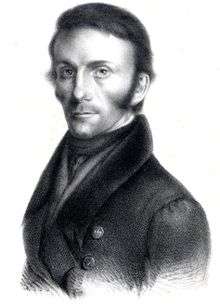Friedrich Parrot

Johann Jacob Friedrich Wilhelm Parrot (14 October 1791[1] – 15 January 1841) was a Baltic German naturalist and traveller, who lived and worked in what was then the Governorate of Livonia, a part of the Russian Empire.[2]
Biography
Born in Karlsruhe, in the Margraviate of Baden, Parrot was the son of Georg Friedrich Parrot. He studied medicine and natural science at the University of Dorpat in present-day Estonia and, in 1811, undertook an expedition to the Crimea and the Caucasus with Moritz von Engelhardt. There he used a barometer to measure the difference in sea level between the Caspian Sea and Black Sea.
On his return he was appointed assistant doctor and, in 1815, surgeon in the Russian army. In 1816 and 1817, he visited the Alps and Pyrenees. In 1821, he was professor of physiology and pathology, then in 1826 professor of physics at the University of Dorpat, and in 1828 Parrot undertook another voyage to Kakheti and Armenia. In 1837 he went to Tornio in northern Finland to observe oscillations of a pendulum and terrestrial magnetism. He invented a gasometer and a baro-thermometer. In Livonia, he popularised the Catalonian sundial, a small, cylindrical, pocket-sized instrument, approximately 8 cm in length and 1.5 cm in diameter.
On 9 October [O.S. 27 September] 1829, Parrot, a pioneer of scientific mountaineering, whilst professor of physics of the University of Dorpat, reached the summit of Mount Ararat (5,137 m) with Khachatur Abovian (the Armenian writer and national public figure), two Russian soldiers, and two Armenian villagers.[3][4] They climbed Ararat from the Armenian monastery of St. Hakob in Akhuri (modern Yenidoğan) in the Surmali region of the Armenian Oblast.[5]
Parrot died in Dorpat (Tartu). He was survived by his daughter, Anna Magaretha Parrot, who married Conrad Jacob Strauch. Their descendants now reside in Australia.
In 2011, a documentary film on Parrot's expedition to Mount Ararat was produced in Estonia by filmmaker Riho Västrik. It was screened at the Golden Apricot International Film Festival in Yerevan in 2013.[6]
Further reading
- Parrot, Friedrich (2016) [1846]. Journey to Ararat. Translated by William Desborough Cooley. Introduction by Pietro A. Shakarian. London: Gomidas Institute. ISBN 978-1909382244.
External links
- Works by or about Friedrich Parrot in libraries (WorldCat catalog)
References
- ↑ (Russian) Паррот Иоганн Якоб Фридрих Вильгельм, Russian Academy of Sciences
- ↑ Joseph Thomas, Universal pronouncing dictionary of biography and mythology, Volume 2, 1901
- ↑ (Estonian) Erki Tammiksaar, Ararat, National Archives of Estonia, 2009
- ↑ Thomas Giles, Friedrich Parrot: The man who became the ‘father of Russian mountaineering’, Russia Beyond the Headlines, 27 April 2016.
- ↑ Philip P. Ketchian, Ararat Redux: Abovian, Prof. Parrot and First Ascent, The Armenian Mirror-Spectator, 13 October 2011.
- ↑ 'Journey to Ararat' Documentary Film, Golden Apricot International Film Festival, July 2013.
| Preceded by Gustav von Ewers |
Rector of University of Dorpat 1830–1834 |
Succeeded by Johann Christian Moier |